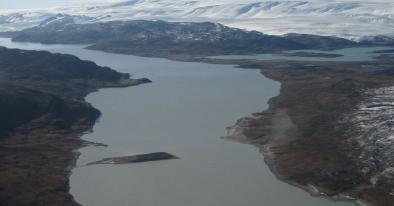Science Source
Drainage of Southeast Greenland Firn Aquifer Water through Crevasses to the Bed
This paper illuminates the fate of the [water of a firn aquifer in the Helheim Glacier catchment of Southeast Greenland]. Before, we didn't know if the water froze inside the ice sheet or reemerged onto the ice surface. In either of those scenarios, the meltwater would not contribute to sea level rise.
Kristin Poinar, lead author of the study and a postdoctoral fellow at NASA's Goddard Space Flight Center in Greenbelt, Maryland
- Finds that cracks in the Greenland Ice Sheet let one of its aquifers drain to the ocean
- Uses a thermo-visco-elastic model for crevasse propagation to calculate the depths and volumes of these water-filled crevasses
- Shows how that surface meltwater can drive crevasses to the top surface of the firn aquifer (~20 m depth), whereupon it receives water at rates corresponding to the water flux through the aquifer
- Finds that crevasses receiving firn-aquifer water hydrofracture through to the bed, ~1000 m below, in 10–40 days
- Finds that englacial refreezing of firn-aquifer water raises the average local ice temperature by ~4°C over a ten-year period, which enhances deformational ice motion by ~50 m year−1, compared to the observed surface velocity of ~200 m year−1
- Finds that were the firn aquifer not present to concentrate surface meltwater into crevasses, no surface melt would reach the bed; instead, it would refreeze annually in crevasses at depths <500 m
Related Content
Science Source
| Geophysical Research Letters
Melting glaciers stimulate large summer phytoplankton blooms in southwest Greenland waters
Kevin R. Arrigo, Gert L. van Dijken, Renato M. Castelao et al
Science Source
| Geophysical Research Letters
Ice Core Records of West Greenland Melt and Climate Forcing
K. A. Graeter, E. C. Osterberg, D. G. Ferris et al
Science Source
| Science Advances
Abrupt shift in the observed runoff from the southwestern Greenland ice sheet
Andreas P. Ahlstrøm, Dorthe Petersen, Peter L. Langen et al
Headline

Dec 15, 2017 | Vox
Greenland's ice sheet is driving global sea level rise. One section is melting 80% faster.


